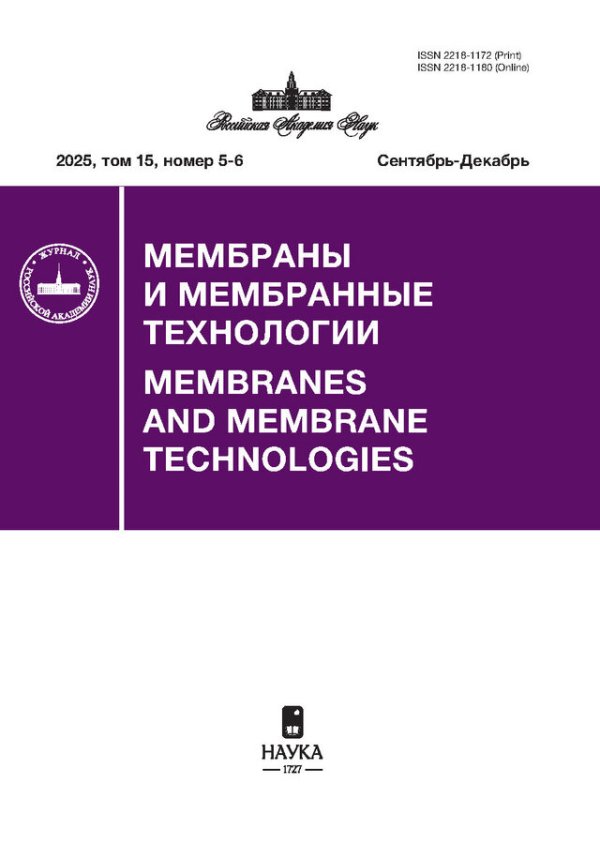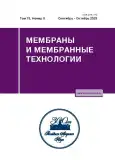Vol 13, No 5 (2023)
Exploring the Production of Sodium Hydroxide via Bipolar Electrodialysis from Sodium Carbonate Solutions
Abstract
This study explores the production of sodium hydroxide via bipolar electrodialysis using MB-3 membranes and a laboratory electrodialyzer-synthesizer with a three-chamber unit cell (five elementary cells, active area of each membrane 1 dm2). The research compares the use of sodium carbonate and sodium sulfate as initial solutions. The results show that sodium carbonate leads to a higher concentration of the resulting alkali under comparable process conditions. The alkali current efficiency is more than 70% when using sodium carbonate, while it drops sharply to 0.4–0.5 when using sodium sulfate. The energy consumption for transferring one kilogram of alkali ranges from 2.8–13.9 kWh/kg at operating current densities of 1–3 A/dm2.
 347-357
347-357


Neutralization Dialysis of Phenylalanine and Mineral Salt Mixed Solution: Effect of Concentration and Flow Rate of Acid and Alkali Solutions
Abstract
Amino acids that are ampholytes can be effectively separated and purified by the method of neutralization dialysis (ND), whose advantage is the ability to control the pH value of the solution without adding reagents. An important task is to optimize the parameters of the ND process to ensure minimal losses of amino acids during their isolation from mixed solutions. An experimental study of the process of demineralization of the phenylalanine and sodium chloride equimolar mixture by the ND method was carried out. It is established that varying the concentration and flow rate of acid and alkali solutions in the corresponding compartments of the dialysis cell allows for regulating the pH value of the solution being desalted and controlling the amount of amino acid loss. Halving the acid concentration (from 0.10 to 0.05 M) allowed reducing the losses of phenylalanine from 18.3 to 16.4%, and using a lower solution flow rate in the acid compartment (0.75 instead of 1.50 cm s–1) made it possible to reduce these losses to 14.2%. At the same time, in all experiments, the electrical conductivity of the desalted solution decreased by 90%, which suggests a high degree of demineralization and the effectiveness of the method used to isolate phenylalanine from the mixed solution.
 358-368
358-368


On the Influence of Counter-Ion Nature on Properties of Perfluorosulfonic Acid Membranes with Long and Short Side Chain
Abstract
In this work, the study of water uptake, ionic conductivity, and Donnan potential in systems with perfluorosulfonic acid membranes in H+, Li+, Na+, and K+ forms and solutions of inorganic electrolytes is presented. The properties of the commercial Aquivion E87-05S and Nafion 212 membranes, as well as the membranes prepared from the dispersions of Nafion 212 in the solvents of different nature (N,N-dimethylformamide, 1‑methyl-2-pyrrolidone, isopropyl alcohol–water mixtures in volume ratio of 80–20) were investigated. The influence of the number of functional groups, the length of the side chains of the polymer macromolecules, and the polymer morphology in the membranes on their equilibrium and transport properties depending on the counter-ion nature was revealed. The effect of the relaxation and electrophoretic factors on the alkali metal ion transfer through the system of pores and channels of the perfluorosulfonic acid membranes was discussed. The slope of the concentration dependencies of the Donnan potential for all highly hydrated membranes in the H+ form was close to the Nernstian one, while the selectivity to the alkali metal ions increased for the membranes with the highest ion-exchange capacity or the lowest amount of sorbed water and diffusion permeability due to the exclusion of the co-ions from the membrane phase.
 369-379
369-379


Deoxygenation of CO2 Solvent Based on Monoethanolamine in Gas–Liquid Membrane Contactors Using Composite Membranes
Abstract
This work is devoted to the removal of dissolved oxygen from a model solvent based on monoethanolamine (MEA) to prevent its oxidative degradation during the absorption purification of flue gases from carbon dioxide. Composite membranes based on porous ceramic and polymer substrates with a thin selective layer of poly[1-(trimethylsilyl)-1-propyne] and its mixture with polyvinyltrimethylsilane have been developed. Gas-liquid membrane contactors have been created on their basis. It is shown that with their use in the vacuum mode, up to 60% of dissolved oxygen can be removed from the model solvent.
 380-392
380-392


Counterion Transference Numbers in the Cell Model of a Charged Membrane
Abstract
The paper suggests exact formulae for calculating the electromigration, diffusion and convective numbers of counterion transport in the cell model of a charged membrane depending on the physicochemical parameters and the equilibrium concentration of the electrolyte. The cell model was previously developed to calculate all the kinetic coefficients of the Onsager matrix and the asymmetry of the cross coefficients was established. The limiting case of an ideally selective membrane is studied in detail, for which approximate formulae for transference numbers are obtained. The obtained dependences are illustrated by graphs using the example of the MK-40 cation-exchange membrane after conditioning at room temperature. The proposed method for calculating the transference numbers is applicable to any single-layer membranes in binary electrolyte solutions.
 393-401
393-401


Experimental Determination of the Gas Transport Characteristics of Polysuflone and Polyphenyleneoxide Hollow-Fiber Membranes in Relation to Noble Gases
Abstract
This paper presents an an experimental study of commercially available hollow fiber membranes made of two polymers, polysulfone and polyphenylene oxide. The main objective is to determine the gas transport characteristics of these membranes with respect to air components and noble gases. Therefore, the permeabilities of the membranes for nitrogen, oxygen, helium, argon, xenon and krypton were determined as part of this study. Particular attention is paid to the xenon-containing air mixture, since the problem of capturing medical xenon seems to be an urgent chemical and technological problem due to the high cost of the process of obtaining this gas. In the course of the study, the values of the permeability of two membranes for pure gases were determined and the values of ideal selectivity were calculated. Thus, the membrane permeability values for argon, krypton, and xenon were 20.8, 8.4, and 6.8 GPU for the polysulfone membrane and 19.5, 6.2, and 4.8 GPU for the polyphenylene oxide membrane. It was found that the xenon permeability of these membranes decreases in the case of separation of a gas mixture consisting of oxygen nitrogen and xenon and is 5.9 and 4.1 GPU for polysulfone and polyphenylene oxide, respectively. The dependence of the performance of membrane modules based on polysulfone and polyphenylene oxide on the total area of the membrane has also been established.
 402-411
402-411


Investigation of Low-Temperature Hydrogen Permeability of Surface Modified Pd–Cu Membranes
Abstract
The Pd60%Cu40% membranes were modified with nanostructured coatings to intensify low-temperature (25–100°C) hydrogen transport. Classical palladium black and filamentous particles were applied as surface modifiers by electrodeposition. The experiment results confirmed significant reducing of surface limitations by modifying layer application on both surfaces of the developed membranes of the Pd60%Cu40% alloy. The study of the developed membranes in the low-temperature hydrogen transport processes demonstrated high and stable flux up to 0.36 mmol s–1 m–2, as well as high hydrogen permeability up to 1.33 × 10–9 mol s–1 m–2 Pa–0.5. In numerical terms, the values of the membranes of the Pd60%Cu40% alloy modified with nanofilaments were up to 1.3 and 3.9 times higher compared to membranes modified with classical black and uncoated ones, respectively. The developed Pd60%Cu40% membranes also demonstrated a high level of H2/N2 selectivity – up to 3552. The strategy of surface modification of palladium-based membranes can shed new light on the development and manufacturing of high-performance and selective membranes for ultrapure hydrogen evolution devices.
 412-422
412-422


Evaluation of the Effect of Electroosmosis on the Efficiency of Electrobaromembrane Separation Using Track-Etched Membranes
Abstract
The results of a theoretical analysis of the influence of the electroosmotic flow on the electromigration and convective transport of competing ions separated by the electrobaromembrane method are presented. Separated ions of the same charge sign move in an electric field through the pores of a track-etched membrane to the corresponding electrode, while due to the pressure drop across the membrane, a commensurate counter convective flow is created. A simplified model based on the equation of convective electrodiffusion and Hagen–Poiseuille equation allows the analysis of experimental data applying only the ion effective transport numbers in the membrane pores as fitting parameters. Using a mathematical model described by the system of equations of Nernst–Planck, Navier–Stokes and Poisson, it is shown that the electroosmotic flow can cause the effective transport numbers of competing ions to exceed their values in solution, even if these ions are coions for the membrane.
 423-432
423-432












